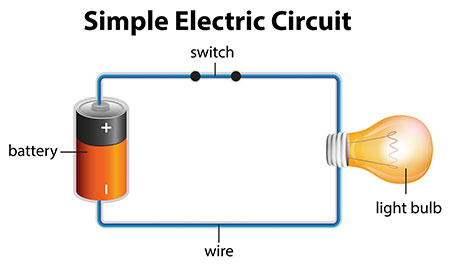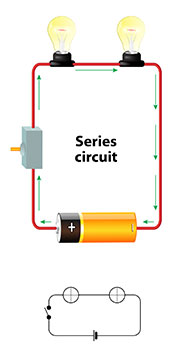Learn
Electric Circuits
Watch the video Electric Circuits (1:24) for a brief introduction to electric circuits. Login instructions.
An electric circuit is a path that charges or electrons flows through.

Read Requirements of a Circuit at the Physics Classroom to learn more.
Most circuits are complex, and it's unlikely you have a device that has a simple circuit as the one shown above. There are two main types of circuits:
- Series Circuit
- Parallel Circuit
In this lesson, we will review series circuits, and then we will review parallel circuits in the following lesson. But first, let's discuss some safety measures involving the safety of circuit.
Electrical Safety
In the United States, most household circuits usually have an average voltage of 120 volts. The amount of current in a circuit can vary, depending on the number of devices that are in the circuit. Each device that is turned on increases the current. If the current exceeds the circuit's safety limit, the wire may overheat and start a fire.
A fuse prevents current overload in a circuit. A wire in the center of the fuse melts if too much current passes through it. This melting is known as “blowing a fuse.” After a fuse blows, it must be replaced with a new fuse before the circuit can carry a current again. Fuses are found in electric devices and automobiles.
Most houses today use circuit breakers instead of fuses to prevent overloads. A circuit breaker is a switch that opens when current in a circuit is too high. The circuit breaker must be reset before the circuit can be used again.
Electrical wiring in a home is insulated to protect people. If the insulation is damaged, you may accidentally touch the bare wire and get a shock. Avoid touching electrical devices with wet hands because your hands conduct current more readily when they are wet.
A ground-fault circuit interrupter (GFCI) is an electrical safety outlet. It monitors current flowing to and from an outlet or appliance. If these two currents are not equal, it means current is escaping. The GFCI opens the circuit to prevent serious electric shocks. These plugs are used on devices with metal exteriors, such as an electric saw. If a short circuit develops, you might get a shock by holding the saw. But instead of entering your body, the current takes an easier path to ground through the grounding wire. The transfer of excess charge through a conductor to Earth is called grounding.
Insulation also prevents short circuits. In a short circuit, current finds a short path through the circuit with less resistance than the full path through the circuit. A three prong plug can prevent shocks caused by short circuits.
Effect of Current on a Person
Imagine what could happen if your body became part of an electric circuit. You might not notice a current of 1 milliamp, but higher currents can be quite dangerous. The table below shows some effects that current can have on a person.
| Current Level | Effect |
|---|---|
| 1 mA | slight tingline sensation |
| 5 mA | slight shock |
| 6-30 mA | painful shock, loss of muscle control |
| 50-150 mA | extreme pain, severe muscular contractions, breathing stops, death is possible |
| 100-4300 mA | nerve damage, heart stops, death is possible |
| 10,000 mA | Severe burns, heart stops, death is probable |
Series Circuit
Watch the video Series Circuits (1:08) for a brief introduction to series circuits. Login instructions.
A series circuit is an electrical circuit where the parts are joined one after another so that the voltage is divided among the devices in the circuit.
- A single pathway is formed for the current to flow through.
- The amount of charge that enters the device is the same amount that exits.

Series circuits are used in flashlights and some Christmas lights. When any part of a series circuit is disconnected, there is no current flowing through the circuit. If you've ever had a whole string of Christmas lights that wouldn't light up because one bulb burned out, that string of lights was a series circuit.
To familiarize yourself with series circuits, review AC/DC: What's the Difference? Login information. On the page, be sure to review the position of the ON / OFF switch in respect to the AC and DC circuits.
Circuit Symbols
You will need to be familiar with the following circuit symbols and diagrams to complete tasks in the next few lessons of this unit. You draw these in your notebook or print the image.
Circuit Symbols

These symbols are used in creating diagrams of different types of circuits. These symbols can be used in diagrams of series circuits and parallel circuits.
Series Circuit Diagrams

Review the following links before continuing. On each page, be sure to build each circuit listed by dragging and dropping the images to the correct symbols on the diagrams.

